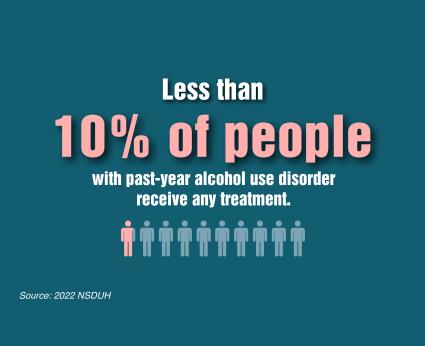Alcohol Treatment in the United States
Prevalence of Past-Year Alcohol Use Treatment
People Ages 12 and Older
According to the 2022 National Survey on Drug Use and Health (NSDUH), 2.2 million people ages 12 and older who had alcohol use disorder (AUD) in the past year (7.6% of people with past-year AUD in this age group) received alcohol use treatment in the past year.1,2 This includes:
- 1.4 million males ages 12 and older (8.2% of males with past-year AUD in this age group)3
- 791,000 females ages 12 and older (6.5% of females with past-year AUD in this age group)3
- 238,000 Black or African American people ages 12 and older (6.6% of Black or African American people with past-year AUD in this age group)3
- 1.6 million White people ages 12 and older (8.6% of White people with past-year AUD in this age group)3
- 23,000 people of two or more races ages 12 and older (3.8% of people of two or more races with past-year AUD in this age group)3
- 273,000 Hispanic or Latino people ages 12 and older (4.8% of Hispanic or Latino people with past-year AUD in this age group)3
- Estimates for American Indian or Alaska Native, Native Hawaiian or other Pacific Islander, and Asian youth ages 12 and older were not presented because they were based on a relatively small number of respondents or had a large margin of error.3
Youth Ages 12 to 17
According to the 2022 NSDUH, 54,000 youth ages 12 to 17 who had AUD in the past year (7.2% with past-year AUD in this age group) received alcohol use treatment in the past year.1,2
This includes:
- 19,000 boys ages 12 to 17 (6.5% of boys with past-year AUD in this age group)3
- 37,000 girls ages 12 to 17 (7.9% of girls with past-year AUD in this age group)3
- 37,000 White youth ages 12 to 17 (9.3% of White youth with past-year AUD in this age group)3
- 7,000 Hispanic or Latino youth ages 12 to 17 (2.9% of Hispanic or Latino youth with past-year AUD in this age group)3
- Estimates for Black or African American, American Indian or Alaska Native, Native Hawaiian or other Pacific Islander, and Asian youth ages 12 to 17, as well as those of two or more races, were not presented because they were based on a relatively small number of respondents or had a large margin of error.3
Adults Ages 18 and Older

According to the 2022 NSDUH, 2.2 million adults ages 18 and older who had AUD in the past year (7.6% of those with past-year AUD in this age group) received alcohol use treatment in the past year.1,2
This includes:
- 1.4 million men ages 18 and older (8.2% of men with past-year AUD in this age group)3
- 754,000 women ages 18 and older (6.5% of women with past-year AUD in this age group)3
- 229,000 Black or African American adults ages 18 and older (6.4% of Black or African American adults with past-year AUD in this age group)3
- 1.6 million White adults ages 18 and older (8.6% of White adults with past-year AUD in this age group)3
- 22,000 adults of two or more races ages 18 and older (3.9% of adults of two or more races with past-year AUD in this age group)3
- 266,000 Hispanic or Latino adults ages 18 and older (4.9% of Hispanic or Latino adults with past-year AUD in this age group)3
- Estimates for American Indian or Alaska Native, Native Hawaiian or other Pacific Islander, and Asian adults ages 18 and older were not presented because they were based on a relatively small number of respondents or had a large margin of error.3
People with AUD were more likely to seek care from a primary care provider for an alcohol-related medical problem rather than specifically for drinking too much alcohol.4,5
Medication-Assisted Treatment
People Ages 12 and Older
Among an estimated 29.5 million people ages 12 and older with past-year AUD in 2022, only 2.1% (or 634,000 people in this age group) received medication-assisted treatment for alcohol in the past year.6,7,8
Youth Ages 12 to 17
Among an estimated 753,000 youth ages 12 to 17 with past-year AUD in 2022, only 1.3% (or 10,000 people in this age group) received medication-assisted treatment for alcohol in the past year.6,7,8
Adults Ages 18 and Older
Among an estimated 28.8 million adults with past-year AUD in 2022, only 2.2% (or 624,000 people in this age group) received medication-assisted treatment for alcohol in the past year.6,7,8

